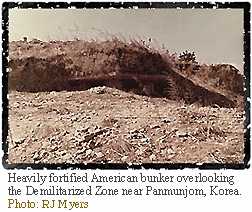

|
|
 The Cold War The Cold WarThe political realities of the Cold War caused the cease-fire line of the Korean War to harden into the permanent Demilitarized Zone (DMZ), which still divides Korea today. The DMZ is a mile-wide strip of no-man's-land, heavily fortified on both sides as indicated by the reinforced defensive bunker pictured at left and the North Korean observation tower on the border shown below. As the years passed, more than two million North Korean soldiers came to face a million South Korean, American, and UN soldiers across the DMZ. In North Korea, Kim Il Sung established himself as absolute dictator and laid the foundation for a family dynasty by giving his son, Kim Jong Il, leading government roles that would position him as successor to his father. The Korean War had caused tremendous damage to North Korea. In the early 1960s the government chose to channel most of its funds and resources into increasing its heavy industrial capacity. The subsequent construction of factories and machinery stimulated considerable growth of the economy, but the emphasis on military and factory production left little for manufacture of consumer products. Consequently, though North Korea's GDP increased significantly, the standard of living for the average North Korean declined. Kim Il Sung ruled until his death in 1994, at the very end of the Cold War. His death created a power vacuum, which his son has not been able to fill entirely, leaving North Korea's political future and its relations with South Korea and the rest of the world uncertain.
The political/military stand-off between North Korea and South Korea has always been tense. In the late 1960s, North Korea returned to a more militant stance towards South Korea, leading to many acts of aggression, including seizure of the U.S.S. Pueblo in 1968, the shooting down of a U.S. reconnaissance plane in 1969, the launching of numerous guerilla raids against the South, and an attempted assassination of President Park. As recently as 1996, incidents making headlines in the U.S. have included a North Korean pilot flying his MIG into South Korea to defect and a commando raid into the South using a small submarine (which was captured).
[ Korea Yesterday ] [ Old Choson Period ] [ The Three Kingdoms ] [ Home ] [ Teacher Pages ] [ Modules & Activities ] |
HTML code by Chris Kreger
Maintained by ETE Team
Last updated April 28, 2005
Some images © 2004 www.clipart.com
Privacy Statement and Copyright © 1997-2004 by Wheeling Jesuit University/NASA-supported Classroom of the Future. All rights reserved.
Center for Educational Technologies, Circuit Board/Apple graphic logo, and COTF Classroom of the Future logo are registered trademarks of Wheeling Jesuit University.